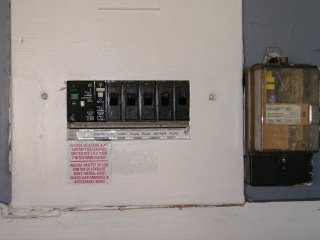Electrical
 Learning how they install electrical systems here has been a challenge. They have a different word for almost everything, so I've had to learn the S.A. word for electrical terms. Their voltage is 220 single phase and 338 three phase. Almost everything runs off of 220 single phase. They don't bond the neutral to ground, so there is a high shock hazard on the neutral, which is something that we don't have in the states. They don't allow receptacles (which they call plugs) in the bathroom, because I'm told that too many people try to use their hairdryer while in the tub. So, Jenny has to do her hair and makeup in the bedroom because that is where the plug is. The oddest thing to me is the logic that they use in regards to how many plugs are allowed on a certain size circuit breaker. I was told by an electrician here that I should only put 4 receptacles in the whole apartment. (Which they call flats.) He said, "All you need is one for an alarm clock, one for a lamp in both rooms, and one for a hair dryer." I said, "What about when I need to plug in my computer, and a night light, and a curling iron, and charge my phone, and charge my camera, and the list goes on." He said something to the effect of "You Americans......" His logic is that if you have more plugs, then people will try to plug in too many things, like a welder, and a drill, and all kinds of other things, and the wire will get overloaded and there will be a fire. So, that is their logic, but what actually happens is that they only have two plugs in a room, so it forces you to plug in a multi plug surge protector, and then one more to that, and then an extension cord, and then another multi plug adapter, and then another extension cord and you have extension cords running all over your room all feeding off of one plug. Now, that is a fire hazard. But then, he tells me that it is common practice to run everything in the kitchen (including a washer, dryer, refrigerator, and counter receptacles off of one 15 amp circuit.) He says, "That is no problem, you won't trip your breaker." So, I'm trying to figure out how they do things, and hopefully I can improve on it a little while still staying within their codes. By the way, the also run almost everything surface mount here. Electrical and plumbing. I'm sure it's because they don't want to deal with the dust it takes to cut it into the wall. But to me, that is a big hazard having 220 volt flexible cable running everywhere.
Learning how they install electrical systems here has been a challenge. They have a different word for almost everything, so I've had to learn the S.A. word for electrical terms. Their voltage is 220 single phase and 338 three phase. Almost everything runs off of 220 single phase. They don't bond the neutral to ground, so there is a high shock hazard on the neutral, which is something that we don't have in the states. They don't allow receptacles (which they call plugs) in the bathroom, because I'm told that too many people try to use their hairdryer while in the tub. So, Jenny has to do her hair and makeup in the bedroom because that is where the plug is. The oddest thing to me is the logic that they use in regards to how many plugs are allowed on a certain size circuit breaker. I was told by an electrician here that I should only put 4 receptacles in the whole apartment. (Which they call flats.) He said, "All you need is one for an alarm clock, one for a lamp in both rooms, and one for a hair dryer." I said, "What about when I need to plug in my computer, and a night light, and a curling iron, and charge my phone, and charge my camera, and the list goes on." He said something to the effect of "You Americans......" His logic is that if you have more plugs, then people will try to plug in too many things, like a welder, and a drill, and all kinds of other things, and the wire will get overloaded and there will be a fire. So, that is their logic, but what actually happens is that they only have two plugs in a room, so it forces you to plug in a multi plug surge protector, and then one more to that, and then an extension cord, and then another multi plug adapter, and then another extension cord and you have extension cords running all over your room all feeding off of one plug. Now, that is a fire hazard. But then, he tells me that it is common practice to run everything in the kitchen (including a washer, dryer, refrigerator, and counter receptacles off of one 15 amp circuit.) He says, "That is no problem, you won't trip your breaker." So, I'm trying to figure out how they do things, and hopefully I can improve on it a little while still staying within their codes. By the way, the also run almost everything surface mount here. Electrical and plumbing. I'm sure it's because they don't want to deal with the dust it takes to cut it into the wall. But to me, that is a big hazard having 220 volt flexible cable running everywhere. 

0 Comments:
Post a Comment
<< Home